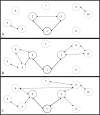Who's Got the Booze? The Role of Access to Alcohol in the Relations Between Social Status and Individual Use
- PMID: 28930063
- PMCID: PMC5675426
- DOI: 10.15288/jsad.2017.78.754
Who's Got the Booze? The Role of Access to Alcohol in the Relations Between Social Status and Individual Use
Abstract
Objective: The findings of previous research that examined relationships between popularity and alcohol use in adolescents have been mixed, and few hypotheses have proposed mechanisms for this relationship. The current study expands on previous literature (a) by examining a possible mechanism that can explain the relation between popularity and alcohol use (home access to alcohol) and (b) by using another sociometric measure ("betweenness"), beyond popularity, that may relate more to home alcohol access.
Method: Using network-level data from adolescents in 9th-11th grades in eight schools within two in-home waves of the National Longitudinal Study of Adolescent to Adult Health (Add Health), we examined two sociometric measures of social status: popularity (number of schoolmates who nominated participants as a friend) and betweenness (level of ties participants have to multiple social subgroups within a network).
Results: Betweenness, but not popularity, related to later alcohol use. Having home access to alcohol positively related to later alcohol use, and having friends with home access to alcohol negatively related to later alcohol use. Alcohol access was also related to later sociometric status. Friends' alcohol access negatively related to later betweenness, and personal alcohol access moderated other pathways predicting betweenness.
Conclusions: Betweenness appears to play a unique role in the association between social status and alcohol use in adolescent social networks. This is potentially tied to specific ways in which adolescents may be able to access alcohol (through home or through friends with access at home). More research is necessary to examine the ways in which multiple sociometric statuses relate to the contexts in which adolescents access and use alcohol.
Figures
Similar articles
-
The role of gender and friends' gender on peer socialization of adolescent drinking: a prospective multilevel social network analysis.J Youth Adolesc. 2014 Sep;43(9):1421-35. doi: 10.1007/s10964-013-0048-9. Epub 2013 Oct 30. J Youth Adolesc. 2014. PMID: 24170437 Free PMC article.
-
Friends' Alcohol-Related Social Networking Site Activity Predicts Escalations in Adolescent Drinking: Mediation by Peer Norms.J Adolesc Health. 2017 Jun;60(6):641-647. doi: 10.1016/j.jadohealth.2017.01.009. Epub 2017 Mar 18. J Adolesc Health. 2017. PMID: 28325545 Free PMC article.
-
Popularity and adolescent friendship networks: selection and influence dynamics.Dev Psychol. 2013 Jul;49(7):1242-52. doi: 10.1037/a0030098. Epub 2012 Sep 17. Dev Psychol. 2013. PMID: 22985296
-
Associations between aspects of friendship networks and dietary behavior in youth: Findings from a systematized review.Eat Behav. 2015 Aug;18:7-15. doi: 10.1016/j.eatbeh.2015.03.002. Epub 2015 Mar 20. Eat Behav. 2015. PMID: 25841218 Review.
-
Using social network methodology to examine the effects of exposure to alcohol-related social media content on alcohol use: A critical review.Exp Clin Psychopharmacol. 2023 Feb;31(1):280-293. doi: 10.1037/pha0000561. Epub 2022 Mar 31. Exp Clin Psychopharmacol. 2023. PMID: 35357872 Free PMC article. Review.
Cited by
-
Social Interaction With an Alcohol-Intoxicated or Cocaine-Injected Peer Selectively Alters Social Behaviors and Drinking in Adolescent Male and Female Rats.Alcohol Clin Exp Res. 2019 Dec;43(12):2525-2535. doi: 10.1111/acer.14208. Epub 2019 Oct 28. Alcohol Clin Exp Res. 2019. PMID: 31585020 Free PMC article.
-
Selection and Socialization Influences on Adolescent Alcohol Use: The Individual and Joint Contexts of Neighborhood Disadvantage and Population Density.Subst Use Misuse. 2019;54(10):1663-1678. doi: 10.1080/10826084.2019.1608247. Epub 2019 May 3. Subst Use Misuse. 2019. PMID: 31046537 Free PMC article.
-
Exposure to alcohol outlets, alcohol access, and alcohol consumption among adolescents.Drug Alcohol Depend. 2019 Dec 1;205:107622. doi: 10.1016/j.drugalcdep.2019.107622. Epub 2019 Oct 17. Drug Alcohol Depend. 2019. PMID: 31760294 Free PMC article.
References
-
- Ali M. M., Amialchuk A., Nikaj S. Alcohol consumption and social network ties among adolescents: Evidence from Add Health. Addictive Behaviors. 2014;39:918–922. doi:10.1016/j.addbeh.2013.11.030. - PubMed
Publication types
MeSH terms
Grants and funding
LinkOut - more resources
Full Text Sources
Medical


